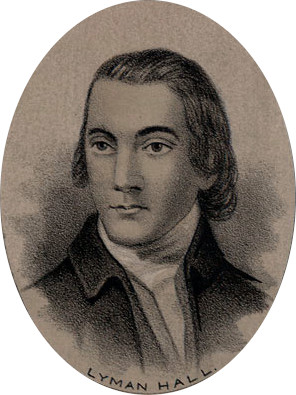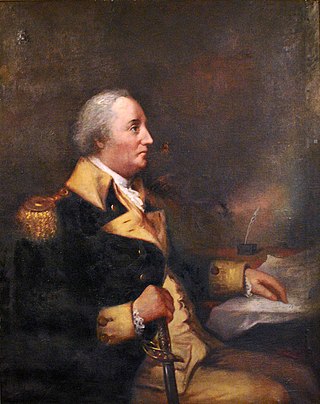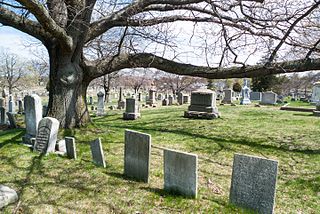
Button Gwinnett was a British-born American Founding Father who, as a representative of Georgia to the Continental Congress, was one of the signers of the United States Declaration of Independence. Gwinnett was also, briefly, the provisional president of Georgia in 1777, and Gwinnett County was named for him. He was named in honor of his mother’s cousin, Barbara Button, who became his godmother. Gwinnett was killed in a duel by rival Lachlan McIntosh following a dispute after a failed invasion of East Florida.

Lyman Hall was an American Founding Father, physician, clergyman, and statesman who signed the United States Declaration of Independence as a representative of Georgia. Hall County is named after him. He was one of four physicians to sign the Declaration, along with Benjamin Rush, Josiah Bartlett, and Matthew Thornton.

George Walton, a Founding Father of the United States, signed the United States Declaration of Independence while representing Georgia in the Continental Congress. Walton also served briefly as the second chief executive of Georgia in 1779 and was again named governor in 1789–1790. In 1795, he was appointed to the U.S. Senate, to complete the unexpired term of a senator who had resigned.

William Whipple Jr. was an American Founding Father and signatory of the United States Declaration of Independence. He represented New Hampshire as a member of the Continental Congress from 1776 through 1779. He worked as both a ship's captain and a merchant, and he studied in college to become a judge. He died of heart complications in 1785, aged 55.

Christ Church Burial Ground in Philadelphia is an important early-American cemetery. It is the final resting place of Benjamin Franklin and his wife, Deborah. Four other signers of the Declaration of Independence are buried here, Benjamin Rush, Francis Hopkinson, Joseph Hewes, and George Ross. Two additional signers of the Declaration of Independence, James Wilson and Robert Morris, are buried at Christ Church just a few blocks away.
John Walton (1738–1783), a Founding Father of the United States, was a Georgia delegate to the Continental Congress. Though born in Virginia, Walton later became a planter near Augusta, Georgia. He was elected as a delegate from St. Paul Parish to the Provincial Congress at Savannah in 1775, and then elected to the Continental Congress in 1778. He signed the Articles of Confederation on behalf of Georgia on July 24, 1778. He held the office of surveyor of Richmond County for several years before his death in New Savannah, Georgia in 1783.

The Granary Burying Ground in Massachusetts is the city of Boston's third-oldest cemetery, founded in 1660 and located on Tremont Street. It is the burial location of Revolutionary War-era patriots, including Paul Revere, the five victims of the Boston Massacre, and three signers of the Declaration of Independence: Samuel Adams, John Hancock, and Robert Treat Paine. The cemetery has 2,345 grave-markers, but historians estimate that as many as 5,000 people are buried in it. The cemetery is adjacent to Park Street Church, behind the Boston Athenæum and immediately across from Suffolk University Law School. It is a site on Boston's Freedom Trail. The cemetery's Egyptian revival gate and fence were designed by architect Isaiah Rogers (1800–1869), who designed an identical gate for Newport's Touro Cemetery.

Richard Howly, sometimes spelled Howley, was an American planter and lawyer from Liberty County, Georgia. He served briefly as the governor of Georgia in 1780, as a delegate to the Continental Congress in 1780 and 1781, and as chief justice of Georgia in 1782 and 1783.

Oakland Cemetery is one of the largest cemetery green spaces in Atlanta, Georgia, U.S. Founded as Atlanta Cemetery in 1850 on six acres (2.4 hectares) of land southeast of the city, it was renamed in 1872 to reflect the large number of oak and magnolia trees growing in the area. By that time, the city had grown and the cemetery had enlarged correspondingly to the current 48 acres (190,000 m2). Since then, Atlanta has continued to expand so that the cemetery is now located in the center of the city. Oakland is an excellent example of a Victorian-style cemetery, and reflects the "garden cemetery" movement started and exemplified by Mount Auburn Cemetery in Massachusetts.

Samuel Elbert was an American merchant, soldier, slave owner, and politician from Savannah, Georgia.

Declaration of Independence is a 12-by-18-foot oil-on-canvas painting by the American artist John Trumbull depicting the presentation of the draft of the Declaration of Independence to Congress. It was based on a much smaller version of the same scene, presently held by the Yale University Art Gallery. Trumbull painted many of the figures in the picture from life, and visited Independence Hall to depict the chamber where the Second Continental Congress met. The oil-on-canvas work was commissioned in 1817, purchased in 1819, and placed in the United States Capitol rotunda in 1826.

The North Burial Ground is a 110-acre (0.45 km2) cemetery in Providence, Rhode Island dating to 1700, the first public cemetery in Providence. It is located north of downtown Providence, bounded by North Main Street, Branch Avenue, the Moshassuck River, and Cemetery Street. Its main entrance is at the junction of Branch and North Main. The burial ground is one of the larger municipal cemeteries in Southern New England, and it accepts 220 to 225 burials per year.
Sunbury is a ghost town in Liberty County, Georgia. Established in 1758, the town was mostly abandoned by the mid-1800s.

College Hill, also known as George Walton House, Harper House, or Walton-Harper House, is a historic house at 2116 Wrightsboro Road in Augusta, Georgia. It was built in 1795, and was the home George Walton, a signer of the United States Declaration of Independence, from then until his death in 1804. It was declared a National Historic Landmark in 1971. It is a private residence, and is not open to the public.

Meadow Garden is a historic house museum at 1320 Independence Drive in Augusta, Georgia. It was a home of Founding Father George Walton (1749–1804), one of Georgia's three signers of the U.S. Declaration of Independence. Walton was later elected governor of Georgia and also served as a United States senator. Meadow Garden was saved by the Daughters of the American Revolution, who established it as a museum in 1901. The house was declared a National Historic Landmark in 1981.
The Province of Georgia was a significant battleground in the American Revolution. Its population was at first divided about exactly how to respond to revolutionary activities and heightened tensions in other provinces. Georgia was the only colony not present in the First Continental Congress in 1774. When violence broke out in 1775, radical Patriots took control of the provincial government, and drove many Loyalists out of the province. Georgia subsequently took part to the Second Continental Congress with the other colonies. In 1776 and 1778, Georgia served as the staging ground for several important raids into British-controlled Florida. The British army captured Savannah in 1778, and the American and French forces failed to recapture the city during the Siege of Savannah in 1779. Georgia remained under British control until their evacuation from Savannah in 1782.

Lachlan McIntosh was a Scottish American military and political leader during the American Revolution and the early United States. In a 1777 duel, he fatally shot Button Gwinnett, a signer of the Declaration of Independence ten months earlier.
The following is a timeline of the history of the city of Augusta, Georgia, USA.

Colonial Park Cemetery is a historic cemetery located in downtown Savannah, Georgia. It became a city park in 1896, 43 years after burials in the cemetery ceased.

Johnson Square is one of the 22 squares of Savannah, Georgia, United States. Located in the northernmost row of the city's five rows of squares, it was the first of the squares to be laid out, in 1733, and remains the largest of the 22. It is east of Ellis Square, west of Reynolds Square and north of Wright Square. Situated on Bull Street and St. Julian Street, it is named for Robert Johnson, colonial governor of South Carolina and a friend of General James Oglethorpe. The oldest building on the square is the Ann Hamilton House, at 26 East Bryan Street, which dates to 1824.
















